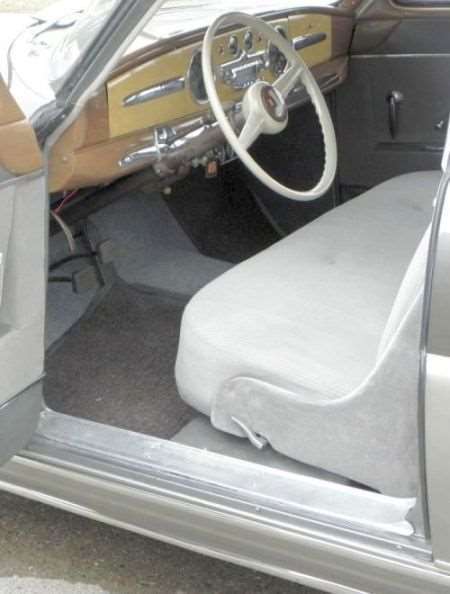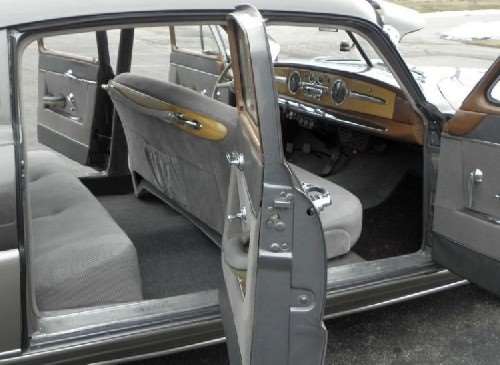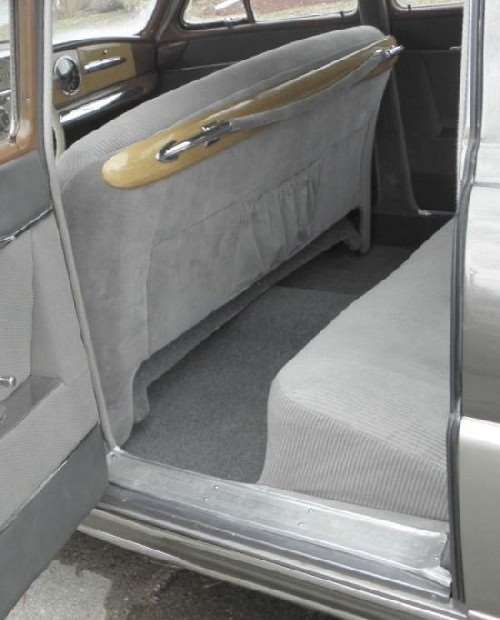Re: SP merger
Posted by 58L8134 On 2015/3/21 16:14:32
Hi
To fit the torsion bar suspension to a revised Step-Down platform, Allison might have had to set aside the interconnected bar concept, instead designed a split bar system: separate sets of bars for front and rear. One problem to overcome was the way the interconnected torsion bars would be installed. At Packard, the suspension components were installed on an inverted chassis frame which more easily allowed loading the full-length bars. The Hudson had a detached front subframe brought together with the body at assembly, that suggest a split bar system installed independently on subframes might have worked best.
The cars still would have benefitted from the improved ride and handling as well as the lower-profile available for stylist to exploit. Leafing through memory, I seem to recall that the Step-Down sunken floors were approximately three-four inches below the top of the outer frame members which were more like five-six inches deep....can anyone verify or correct? (Need to find the early SIA article) The attached photos suggest if they were able to run the torsion bars under the floor wells, they would have had scant but sufficient clearance. Attachment points for a split-bar system would have been under the seats as Chrysler did only for the front for 1957.
Looking at the Hudson subframe, the front suspension could have been fitted with torsion bars in the same way Packard did. The rear frame section behind the passenger area would have had to have been re-engineered to route the main frame units inside the wheels, allowing a 60" plus rear track, rather than its 55" track. Proportioning for the long Hornet 308 would accommodate the V8 easily, have yielded a nice, long front end which Packard and Hudson should have held onto as part of their identity. Varying mid-section and rear deck lengths would give each make distinct proportions. Although reworking a late 1940's platform to create a new mid-1950's line might seem counter-intuitive, that aging platform had the one advanced feature that would soon become standard industry practice. For Packard-Hudson, it would have been a interim series but what was learned doing it would have carried over well into an all-new 1958 or 1959 body series.
In general, the era of the six cylinder medium-priced car was diminishing by 1955-56 but as long as Hudson loyalist kept buying a sufficient number to keep production of the Hornet 308 ci viable, they should have continued to offer them. Until the 320 V8 became the preferred Hudson engine, the Hornet 308's fine reputation should have been capitalize upon. Directing Hudson engineering to develop a high-efficiency OHC six for a new compact/intermediate line in the early 1960's would have been a great diversification move to keep the company profitable.
RE: a post-U.S. Jet: Although Hudson and Murray might have been able to peddle the Jet tooling there, to assist their recovering economies European countries had levied high import tariffs to protect their national auto industries still rebuilding after the war. The narrow Jet width would have fit the European roads in most nations better than here. The Jet might also have found a second life in Asia or India which had need for small, economical cars. Latin America seems to have been a best prospect, Kaiser was quite aggressive getting his 'leftover' cars back into production there. Fortuitously, the Henry J tooling went missing before it got there.....
Steve
PS: my source tells me the all-new 1957's were to have a split bar system with hydraulic leveler, with 125" and 130" wheelbases for different series.
Attach file:
 (24.87 KB)
(24.87 KB)

 (39.97 KB)
(39.97 KB)

 (31.33 KB)
(31.33 KB)

To fit the torsion bar suspension to a revised Step-Down platform, Allison might have had to set aside the interconnected bar concept, instead designed a split bar system: separate sets of bars for front and rear. One problem to overcome was the way the interconnected torsion bars would be installed. At Packard, the suspension components were installed on an inverted chassis frame which more easily allowed loading the full-length bars. The Hudson had a detached front subframe brought together with the body at assembly, that suggest a split bar system installed independently on subframes might have worked best.
The cars still would have benefitted from the improved ride and handling as well as the lower-profile available for stylist to exploit. Leafing through memory, I seem to recall that the Step-Down sunken floors were approximately three-four inches below the top of the outer frame members which were more like five-six inches deep....can anyone verify or correct? (Need to find the early SIA article) The attached photos suggest if they were able to run the torsion bars under the floor wells, they would have had scant but sufficient clearance. Attachment points for a split-bar system would have been under the seats as Chrysler did only for the front for 1957.
Looking at the Hudson subframe, the front suspension could have been fitted with torsion bars in the same way Packard did. The rear frame section behind the passenger area would have had to have been re-engineered to route the main frame units inside the wheels, allowing a 60" plus rear track, rather than its 55" track. Proportioning for the long Hornet 308 would accommodate the V8 easily, have yielded a nice, long front end which Packard and Hudson should have held onto as part of their identity. Varying mid-section and rear deck lengths would give each make distinct proportions. Although reworking a late 1940's platform to create a new mid-1950's line might seem counter-intuitive, that aging platform had the one advanced feature that would soon become standard industry practice. For Packard-Hudson, it would have been a interim series but what was learned doing it would have carried over well into an all-new 1958 or 1959 body series.
In general, the era of the six cylinder medium-priced car was diminishing by 1955-56 but as long as Hudson loyalist kept buying a sufficient number to keep production of the Hornet 308 ci viable, they should have continued to offer them. Until the 320 V8 became the preferred Hudson engine, the Hornet 308's fine reputation should have been capitalize upon. Directing Hudson engineering to develop a high-efficiency OHC six for a new compact/intermediate line in the early 1960's would have been a great diversification move to keep the company profitable.
RE: a post-U.S. Jet: Although Hudson and Murray might have been able to peddle the Jet tooling there, to assist their recovering economies European countries had levied high import tariffs to protect their national auto industries still rebuilding after the war. The narrow Jet width would have fit the European roads in most nations better than here. The Jet might also have found a second life in Asia or India which had need for small, economical cars. Latin America seems to have been a best prospect, Kaiser was quite aggressive getting his 'leftover' cars back into production there. Fortuitously, the Henry J tooling went missing before it got there.....
Steve
PS: my source tells me the all-new 1957's were to have a split bar system with hydraulic leveler, with 125" and 130" wheelbases for different series.
Attach file:
 (24.87 KB)
(24.87 KB)
 (39.97 KB)
(39.97 KB)
 (31.33 KB)
(31.33 KB)
This Post was from: https://packardinfo.com/xoops/html/modules/newbb/viewtopic.php?post_id=159261